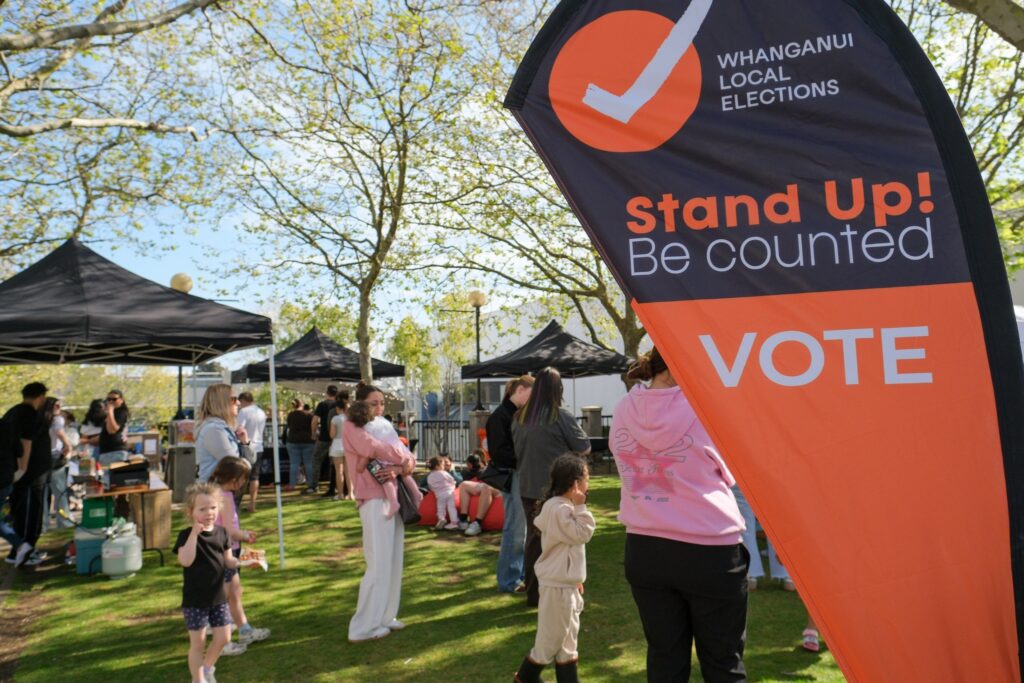
By Moana Ellis, Local Democracy Reporting
Whanganui has recorded its highest local election turnout in nearly a decade, with more than half of eligible voters casting their votes in the 2025 local body elections.
Whanganui District Council confirmed a final voter turnout of 50.32 percent, the district’s best result since 2016 and one of the highest among larger districts nationwide.
The strong engagement comes alongside a decisive Māori Ward referendum result, with a majority of 8292 votes in favour of keeping the new ward – an 830-vote margin over the 7462 who voted against.
The binding result means the Māori ward will remain in place for the 2028 and 2031 elections.
Julie Herewini and Geoff Hipango were elected from a field of five candidates to represent the new ward.
Mayor Andrew Tripe secured a commanding return to office with 9147 votes, ahead of Josh Chandulal-Mackay (5286), Peter Oskam (1895) and Gregory McPhee (295).
Tripe led the council as it achieved the lowest average rates increase of the country, at 2.2 percent for 2025-26.
“[It] didn’t happen by accident – it’s the result of a deliberate strategy to keep costs under control,” Tripe said at the time.
Ten councillors were elected to the general ward: Philippa Baker-Hogan, Glenda Brown, Josh Chandulal-Mackay, Ross Fallen, Mike Hos, Kate Joblin, Michael Law, Charlotte Melser, Peter Oskam and Rob Vinsen. All except newcomer Mike Hos are returning councillors.
Of the 10, Law was the top-polling candidate with 8990 votes, followed by Chandulal-Mackay (8712) and Joblin (8617).
Elected to the Whanganui Rural Community Board were David Wells and Daryn Te Uamairangi (Whanganui Community subdivision). In the Kai Iwi subdivision, Jack Bullock, Brian Doughty and Quentin Handley were elected unopposed, while in Kaitoke, Charlie Anderson and Bill Ashworth were also elected unopposed.
Council democracy services manager Anna Palamountain said reaching the 50 percent milestone was a significant achievement at a time when local election turnout has been trending downward across most of Aotearoa.
“This result means more than half of eligible voters in Whanganui have stood up and been counted, which is really pleasing to see. The last time we achieved that feat was in 2016 – so as a community we should be proud,” she said.
Palamountain said that among districts with 30,000 electors or more, Whanganui may have finished with the highest voter turnout in the country.
“We’re still waiting on some results to be declared by a handful of councils, but at this stage we are tracking to be right up there with the highest turnouts for larger districts.
“As a town we have a strong history of civic pride and community engagement – and I think we saw that again this election.”
She said the result was driven by “real collective effort” to boost participation – “whether it was the council staff working late (or over weekends) to help people vote, the community organisations who held ‘meet the candidates’ nights or pop-up voting events, the businesses who hosted orange voting bins, [or] the performers who lit up our Up the Vote event”.
The national average turnout will be confirmed by the Department of Internal Affairs once all councils finalise their results.
Awa FM – Te Reo Irirangi o Whanganui
For more of our people, our stories, our way, click News or follow us on Facebook.
